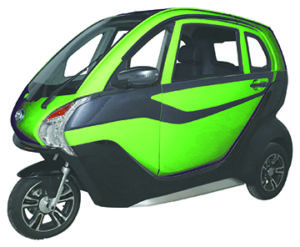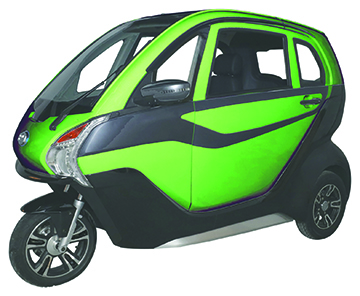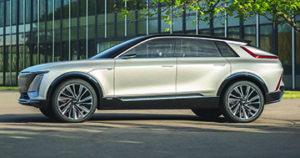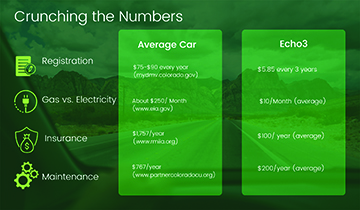“They say the universe is expanding. That should help with the traffic.”
- Steven Wright
Over the past two decades, Denver has undergone a high-speed growth spurt, transforming from an adolescent urban sprawl to a metropolitan powerhouse of international renown.
The spoils of rapid growth are not without consequence, however, as infrastructure scrambles to keep up with influx. One of the negative results — experienced by anyone who travels the Mile High City streets in a moving vehicle — is profound traffic congestion.
The next time you’re sitting in 3:45 p.

Echo3 electric vehicles are enclosed, designed for three adults and classified in Denver as scooters.
m. pre-rush hour traffic as your idling car burns gasoline, make note of your reaction when the inevitable hipster on an electric scooter zips past you and your stranded peers and continues along to their destination. As you languish in an automotive bottleneck, resenting the efficiency with which someone half your age goes twice your speed for a fraction of the money, consider that — just maybe — they might be onto something.
In addition to presenting a profound solution to global warming (EVs produce zero tailpipe emissions and far fewer life cycle emissions), electric vehicles may hold the key to reducing traffic jams. Sure, the hipster scooter or e-bike may not be your cup of small-batch, hand-crafted tea, but there are other options in the EV market that may shorten and simplify your daily drive time. Plus, over the long haul, EVs can most certainly save you money. Ultimately, EVs present several advantages that could, if adopted by a significant number of residents, put a dent in a traffic problem and pollution level that ranks Denver as one of the worst cities to drive and breathe in.
Sharable EVs: Bikes and Scooters
(App-guided Acquisition)
Currently, just two vendors have been authorized by Denver City Council to operate bike and scooter services across the city. Lime and Lyft were awarded contracts while other vendors — some in business locally since 2018 — have been forced to hit the road. Politics notwithstanding, the availability of these recently-dubbed “micromobility” products has been and will be critical to reducing traffic — especially for folks with errands and work commutes that are relatively close to home. Rather than fire up the ol’ gas guzzler to go to the post office down the street and back, a quick trip on a shared EV can get the job done at the same time at a fraction of the cost and with little or no stoplight migraines or parking nightmares. OK, so you might look a little silly slogging to a meeting on a souped-up kick’n’go while your fellow citizens slosh snow and mud all over your tailored suit, but there are weatherproof upgrades for determined conservationists.
In addition to being incredibly convenient, micromobility transportation creates zero carbon emissions, zero noise pollution, can be parked anywhere, and may also be offsetting the collective occupancy of RTD systems. You will never, ever sit in a traffic jam on one of these EVs. Among the down sides is that while they do not require a license to operate, you must be 16 years of age.
Echo3 EVs
(329 Santa Fe Dr., Denver, CO 80223)
In a promotional YouTube video sponso
red by Colorado & Company/KUSA TV, Echo3 President Rex Halbeisen urges Denver residents to “reevaluate your short trip transportation.” The company delivers, designs and manufactures “the world’s most efficient electric vehicles.” Halbeisen continues with an interesting metric, “78.5% of trips you take are within three miles of your house.” This data demonstrates that three of every four times you fire up your combustion engine vehicle may be unnecessary. Instead, the errand can be accomplished in one of Echo3’s sleek, enclosed, three passenger, scooter-like vehicles. In Colorado, these EVs are classified as low-powered scooters, meaning insurance rates pale in comparison to those of a car, truck, or SUV. It doesn’t take much imagination to realize that a gridlock traffic jam situation where even a fraction of the vehicles are Echo3s is dang-near impossible.
Meanwhile, company marketing director Madeline Espinoza describes more ways in which Echo3 EVs can help reduce everyday vehicle-related headaches. “They go 35 mph, so road rage is impossible,” she begins. “They are street legal, yet you can park them on the sidewalk just like an electric scooter. The benefit of these vehicles is they are enclosed, so they can be used year-round, and I even have snow chains for them. And, if you’re in the city just trying to bop around, this is a really efficient way to do so” she explains.
While never having to shell out money for gas and carrying very affordable insurance are standout benefits, the ability to simply park on the sidewalk is reason enough by itself to entice any longtime Denverite. Espinoza also points out that an Echo3 is cheaper than an RTD pass, offers a reduced-stress driving experience and is even ideal for rural areas. “I drive mine from Littleton to our dealership on Santa Fe Drive. I just take Broadway all the way up,” she says.
(257 Fillmore St., Denver, CO 80206)
This new line of EVs developed by Volvo and Geely was launched in 2017 from the former’s headquarters in Gothenburg, Sweden. Concerning user experience, Business Insider recently reported, “The interior is built to be something an actual human would use and enjoy — not a button-free, avant-garde exercise in alternative design. This is the all-new Polestar 2, you see, and it drives like a finished version of the [Tesla] Model 3.” The January, 2021, review also praises the Polestar 2 as “more substantive, more satisfying,” so perhaps this product may offset the propensity for road rage due to extremely satisfied and subdued drivers. At any rate, despite the potential sticker shock some buyers may experience, the company’s goals are noble. Polestar’s Head of Sustainability, Fredrika Klarén explains, “As an electric car maker, we don’t have to worry about combustion engines producing toxic emissions, but that doesn’t mean our job is done. Now we must focus all our efforts on cutting emissions in the supply chain and in the production of our cars. This is a historic and exciting time for car makers, an opportunity to seize the moment and do better. For the first time, we can dare to dream about a future with climate-neutral, circular, but still beautiful cars, and the human right of air that is cleaner to breathe.”
This contingency of the electric vehicle marketplace also includes the ubiquitous brand Tesla as well as cutting edge offerings from Hyundai, Ford, Audi, and more. These EVs are poised to offset the lasting effects of traffic congestion — global warming — while reducing America’s number one contributor to global warming pollution — motorized transportation. Although bad attitudes from sitting in three-hour traffic jams eventually dissipate, greenhouse gases trapped in the troposphere do not.





